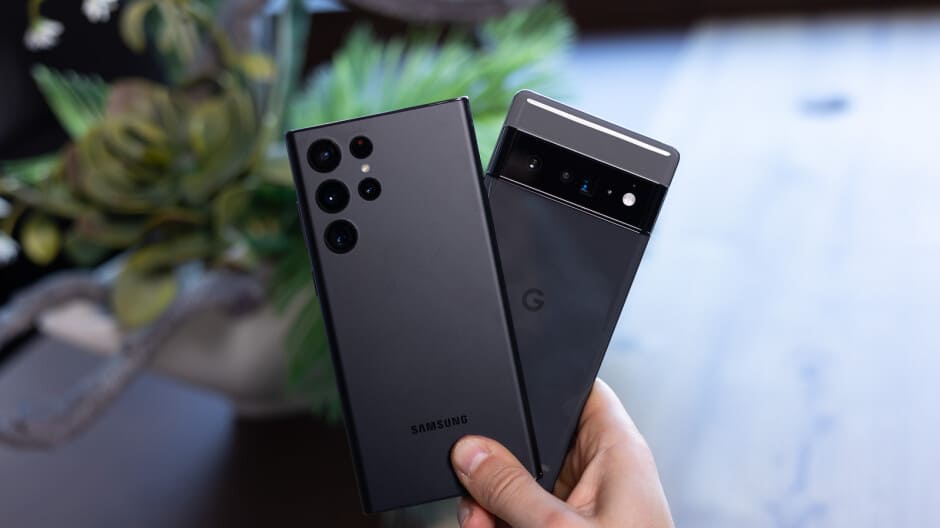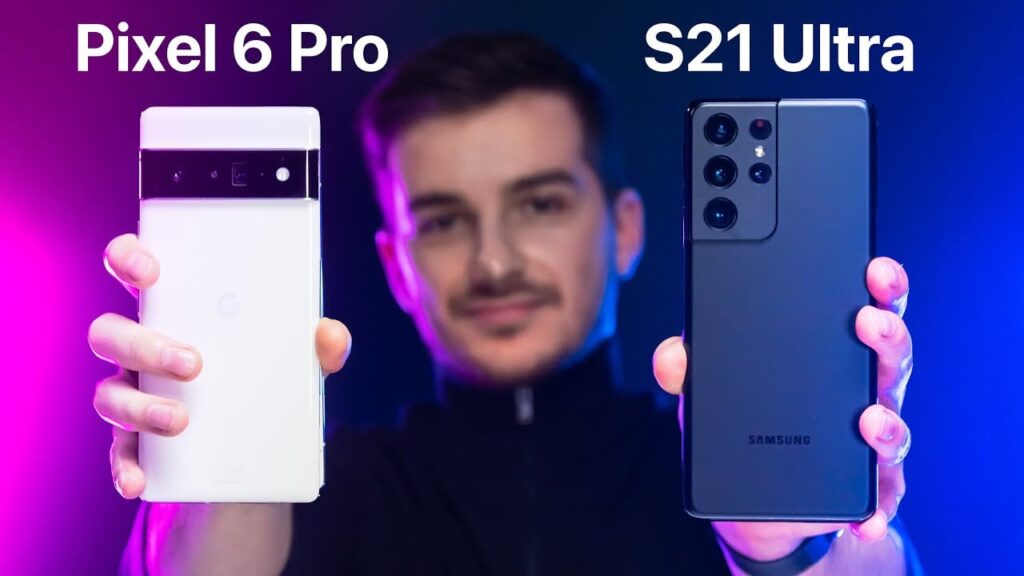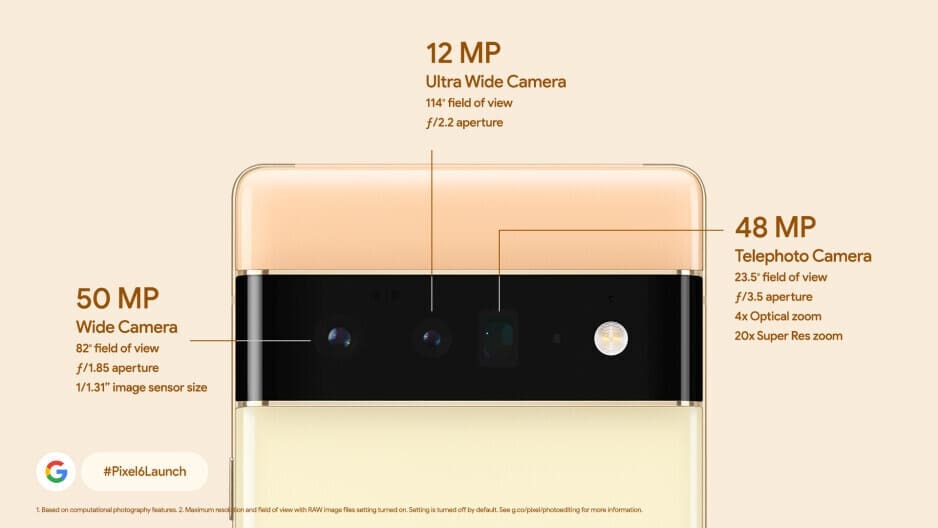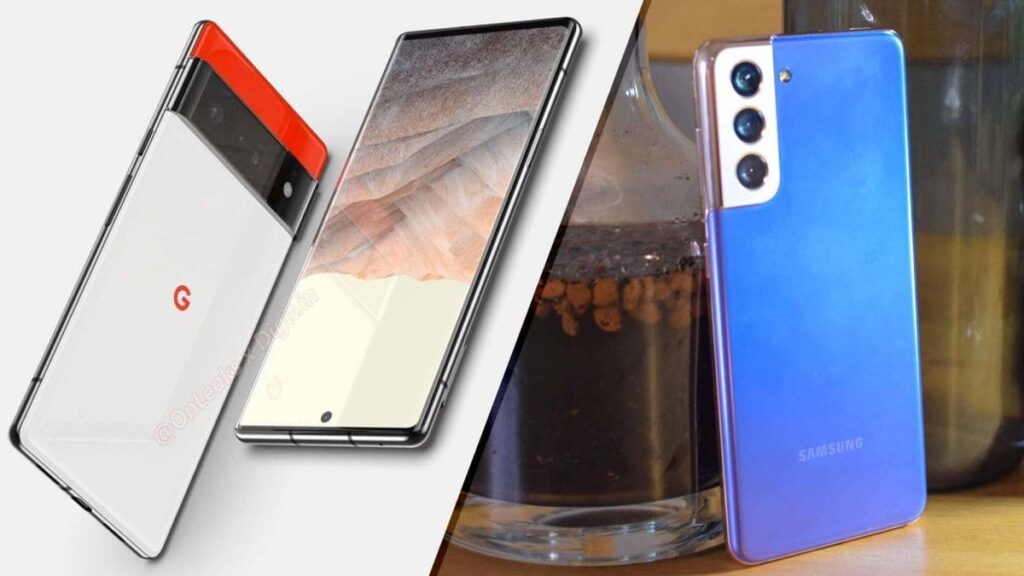Introduction
Comparison between different products is relevant when people try to make informed decisions about which product to purchase. In this case, we will be comparing the Pixel 6 and the S21 Ultra, which are two high-end smartphones.
The Pixel 6 is a smartphone developed by Google and was released in 2021. It comes with a 6.4-inch OLED display, a 50-megapixel main camera, and a 12-megapixel ultra-wide camera. The phone is powered by Google’s own Tensor processor and runs on the Android 12 operating system. It also features a 4,614 mAh battery, 8GB of RAM, and up to 256GB of storage.
The S21 Ultra, on the other hand, is a smartphone developed by Samsung and was released in early 2021. It features a 6.8-inch Dynamic AMOLED display, a 108-megapixel main camera, and a 12-megapixel ultra-wide camera. The phone is powered by the Exynos 2100 or Snapdragon 888 processor (depending on the region) and runs on the Android 11 operating system. It also features a 5,000 mAh battery, up to 16GB of RAM, and up to 512GB of storage.
Both phones offer top-of-the-line features and specifications, making them attractive options for those in the market for a high-end smartphone.
Camera Specs Comparison
Megapixels:
The Pixel 6 has a 50-megapixel primary camera and a 12-megapixel ultra-wide camera. The S21 Ultra, on the other hand, has a 108-megapixel primary camera, a 12-megapixel ultra-wide camera, and two 10-megapixel telephoto cameras.
Sensor size:
The Pixel 6’s primary camera has a 1/1.31-inch sensor, while the S21 Ultra’s primary camera has a larger 1/1.33-inch sensor. However, it’s worth noting that sensor size isn’t the only factor that affects image quality.
Aperture:
The Pixel 6’s primary camera has an f/1.85 aperture, while the S21 Ultra’s primary camera has an f/1.8 aperture. The ultra-wide cameras on both phones have an f/2.2 aperture.
Focal length:
The Pixel 6’s primary camera has a 26mm focal length, while the S21 Ultra’s primary camera has a 24mm focal length. The telephoto cameras on the S21 Ultra have 70mm and 240mm focal lengths.
Zoom capabilities:
The Pixel 6 doesn’t have a dedicated telephoto camera and relies on digital zoom. The S21 Ultra has two telephoto cameras, which enable up to 10x hybrid optical zoom and up to 100x Space Zoom.
Optical Image Stabilization:
Both the Pixel 6 and S21 Ultra have Optical Image Stabilization (OIS) for their primary cameras, which helps reduce camera shake and produce sharper images. The S21 Ultra also has OIS for its telephoto cameras.
Other camera features:
Both phones have advanced camera features such as Night Sight and Portrait Mode, which help capture better photos in low-light situations and create professional-looking portrait photos with blurred backgrounds. The S21 Ultra also has a 108-megapixel sensor, which allows for high-quality 8K video recording. Additionally, the S21 Ultra has laser autofocus, which helps with faster and more accurate focusing.
Camera Performance Comparison

Low light photography:
Both phones have excellent low-light photography capabilities, thanks to their advanced camera software and image processing algorithms. The Pixel 6 has Night Sight, which allows users to capture brighter and more detailed photos in low-light conditions, while the S21 Ultra has Night mode, which also improves image quality in low-light situations.
Daylight photography:
Both phones perform well in daylight photography, producing sharp and vibrant images with accurate colors. The S21 Ultra’s higher megapixel count and larger sensor size give it an advantage in terms of detail and dynamic range, while the Pixel 6’s computational photography algorithms help produce well-balanced and visually pleasing images.
Portrait mode:
Both phones have advanced portrait mode capabilities that allow users to capture professional-looking portrait photos with blurred backgrounds. The S21 Ultra has a more versatile camera setup, with multiple cameras that enable more accurate depth sensing and more flexible portrait mode options.
Selfie camera:
Both phones have high-quality selfie cameras, capable of capturing detailed and well-exposed photos. The Pixel 6 has an 8-megapixel front-facing camera, while the S21 Ultra has a 40-megapixel front-facing camera.
Video recording capabilities:
Both phones can record high-quality video at up to 4K resolution, with good stabilization and detail. The S21 Ultra has the added advantage of being able to shoot 8K video, thanks to its high-megapixel sensor.
Slow-motion video: Both phones can shoot slow-motion video, with the S21 Ultra being able to shoot at a higher frame rate of up to 960fps, compared to the Pixel 6’s 240fps.

Camera software features and user interface:
Both phones have intuitive and easy-to-use camera interfaces, with quick access to advanced features like manual controls and HDR mode. The Pixel 6’s camera software is heavily focused on computational photography and features like Night Sight and Motion Mode, while the S21 Ultra’s camera software has a wider range of features, including Pro mode, Super Slow-mo, and Director’s View.
Computational photography:
Both phones use advanced computational photography algorithms to enhance image quality, including HDR processing, noise reduction, and auto white balance. The Pixel 6’s camera software is particularly focused on computational photography, with features like Magic Eraser and Motion Mode, which allow users to create unique and visually striking photos.
Other Features Comparison
Display quality:
The Pixel 6 has a 6.4-inch Full HD+ display with a resolution of 2400 x 1080 pixels, while the S21 Ultra has a larger 6.8-inch Quad HD+ display with a resolution of 3200 x 1440 pixels. Both phones use AMOLED technology and have high-quality displays with vibrant colors and deep blacks. However, the S21 Ultra’s larger and higher-resolution display gives it an advantage in terms of detail and screen real estate.
Battery life:
The Pixel 6 has a 4600mAh battery, while the S21 Ultra has a larger 5000mAh battery. Both phones have excellent battery life, with the S21 Ultra being able to last slightly longer due to its larger battery size.
Processor and RAM:
The Pixel 6 is powered by Google’s own Tensor chip, which has 8GB of RAM, while the S21 Ultra is powered by a Qualcomm Snapdragon 888 processor with 12GB of RAM. Both phones have powerful processors and plenty of RAM, which enables smooth multitasking and speedy performance.
Operating system and updates:
The Pixel 6 runs on the latest version of Android 12, with guaranteed updates for at least three years. The S21 Ultra runs on Android 11 with Samsung’s One UI 3.1, with guaranteed updates for three years. Both phones have excellent software support and receive regular security updates.
Design and build quality:
The Pixel 6 has a modern and sleek design, with a smooth glass back and a distinctive camera bar on the back. The S21 Ultra has a more traditional design, with a metal frame and a glass back. Both phones have the fantastic build quality, with premium materials and a solid feel in the hand.
Water and dust resistance:
Both phones have an IP68 rating for water and dust resistance, which means they can survive being submerged in up to 1.5 meters of water for up to 30 minutes without any damage.
Connectivity options:
Both phones have 5G connectivity, as well as Wi-Fi 6, Bluetooth 5.2, and NFC. The S21 Ultra also has UWB (Ultra Wideband) technology, which allows for more precise location tracking and device pairing.
User Experience Comparison

Ease of use and navigation:
Both the Pixel 6 and S21 Ultra have intuitive and user-friendly interfaces, with easy navigation and access to key features. The Pixel 6 has a simpler and more streamlined interface, with a focus on Google’s services and apps, while the S21 Ultra has a more feature-rich interface with Samsung’s One UI.
User reviews and feedback:
Both phones have received positive reviews from users and tech reviewers, with high marks for their camera performance, display quality, and overall user experience. However, the Pixel 6 has been praised for its software updates and clean Android experience, while the S21 Ultra has been praised for its large and high-quality display and extensive feature set.
Brand loyalty and reputation:
Both Google and Samsung have strong reputations in the tech industry, with loyal fan bases and a track record of delivering high-quality products. Google is known for its software and AI capabilities, while Samsung is known for its hardware and design prowess. Users who have owned previous devices from either brand may be more likely to stick with their preferred manufacturer for their next purchase.
Price Comparison
Retail prices:
The Pixel 6 starts at $599 for the 128GB model, while the S21 Ultra starts at $1,199 for the 128GB model. The S21 Ultra also has a more expensive 512GB model for $1,399. The Pixel 6 is significantly cheaper than the S21 Ultra, making it a more affordable option for those on a budget.
Carrier and contract options:
Both phones are available from major carriers such as Verizon, AT&T, T-Mobile, and others. Carrier pricing varies depending on the carrier and plan selected, but both phones can be purchased on installment plans over a period of 24 or 36 months. The Pixel 6 is also available for purchase from Google’s website and other retailers, while the S21 Ultra is available from Samsung’s website and other retailers.
Trade-in deals and promotions:
Both Google and Samsung offer trade-in deals and promotions for their phones, which can help to offset the cost of a new device. Trade-in values and promotions vary depending on the device being traded in and the current offers available, so it’s worth checking with each manufacturer to see what options are available. Additionally, carriers may also offer their own trade-in deals and promotions, so it’s worth checking with them as well. Trade-in deals and promotions can help to reduce the cost of a new phone and make it more affordable for consumers.
Pros and Cons of Each Camera
- Pixel 6
- S21 Ultra

Pixel 6 Camera:
Pros:
- Excellent low-light photography with Night Sight mode
- Advanced computational photography features like Magic Eraser and Face Unblur
- The fast and responsive camera app
- High-quality 4K video recording
- Telephoto lens for better zoom capabilities
- Improved Portrait mode with better depth sensing
Cons:
- Limited zoom capabilities compared to other flagship phones
- No ultra-wide angle lens
- No Pro mode for manual control over camera settings
- Some users may prefer a more natural color profile for photos
S21 Ultra Camera:
Pros:
- Four rear cameras including an ultra-wide angle lens and a periscope-style telephoto lens
- Up to 100x zoom capabilities with Space Zoom
- 8K video recording
- Bright and vibrant photos with accurate color reproduction
- Multiple camera modes for different shooting scenarios
- Pro mode for manual control over camera settings
Cons:
- Images can be over-sharpened at times
- The camera app can be sluggish and slow to respond
- The phone can become hot when using the camera for extended periods
- Night mode performance is good, but not as strong as some other phones
- Some users may find the camera module to be bulky and intrusive
Final Verdict
Based on the comparison of the Pixel 6 and S21 Ultra,
Both phones have their strengths and weaknesses when it comes to camera performance. However, the Pixel 6’s camera excels in low light photography and advanced computational photography features, while the S21 Ultra’s camera has a more versatile range of lenses and better zoom capabilities.
The Pixel 6 is a great option for those who prioritize low-light photography and want a simpler, more streamlined camera interface. The advanced computational photography features also make it a good choice for those who want to experiment with more creative photography techniques.
On the other hand,
The S21 Ultra is a better choice for those who want a more versatile camera system with better zoom capabilities and a range of lenses. The phone’s pro mode also allows for more manual control over camera settings, which can be helpful for more advanced photographers.
In terms of overall recommendations,
It depends on the individual’s needs and preferences. The Pixel 6 is a more affordable option with a focus on software and computational photography, while the S21 Ultra is a more expensive flagship phone with a range of features and capabilities. Ultimately, it’s important to consider factors like budget, camera needs, and overall phone preferences when deciding between the two.
Conclusions

Both the Pixel 6 and S21
Ultra has its strengths and weaknesses when it comes to camera performance. The Pixel 6 offers excellent low-light photography and advanced computational photography features, while the S21 Ultra has a more versatile camera system with better zoom capabilities and a range of lenses.
Ultimately,
The choice between the two will depend on the individual’s needs and preferences. The Pixel 6 is a more affordable option with a focus on software and computational photography, while the S21 Ultra is a more expensive flagship phone with a range of features and capabilities. It’s important to consider factors like budget, camera needs, and overall phone preferences when deciding between the two.
Both phones offer excellent camera performance and are solid choices for anyone looking for a high-end smartphone with a great camera.
FAQs
What is computational photography?
Computational photography refers to the use of algorithms and software to enhance and manipulate images. It can be used to improve image quality, add special effects, and create new types of images that were not previously possible.
How does the camera software affect image quality?
Camera software plays a significant role in image quality. The software can affect settings such as exposure, focus, and white balance, as well as additional features like image stabilization and noise reduction. The quality of the software can impact the overall image quality of the camera.
Is the Pixel 6 or S21 Ultra better for video recording?
Both the Pixel 6 and S21 Ultra have excellent video recording capabilities, but the S21 Ultra is better suited for high-quality video due to its better stabilization and more versatile camera system.
Can the S21 Ultra zoom further than the Pixel 6?
Yes, the S21 Ultra has better zoom capabilities than the Pixel 6, with a 10x optical zoom compared to the Pixel 6’s 4x digital zoom.
Which phone has better low-light performance?
The Pixel 6 has better low-light performance than the S21 Ultra, thanks to its larger sensor and advanced computational photography capabilities.
Does the Pixel 6 have a headphone jack?
No, the Pixel 6 does not have a headphone jack.
Which phone has better battery life?
Battery life can vary depending on usage, but generally, the S21 Ultra has better battery life than the Pixel 6 due to its larger battery capacity
What is the water resistance rating of each phone?
The Pixel 6 has an IP68 water resistance rating, which means it can withstand immersion in up to 1.5 meters of water for up to 30 minutes. The S21 Ultra has a slightly better rating of IP68+.
Can I use the Pixel 6 or S21 Ultra on any carrier?
Both phones are compatible with most carriers, but it’s always best to check with your carrier to ensure compatibility.
Which phone has a better design?
Design is a matter of personal preference, but the S21 Ultra has a more premium and sleek design with a glass back and metal frame, while the Pixel 6 has a more unique and playful design with a colorful camera module and a textured back.


